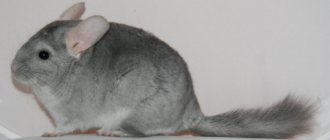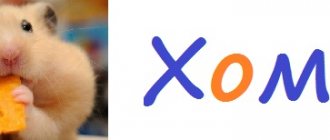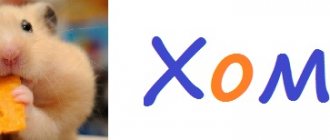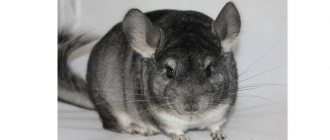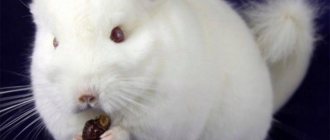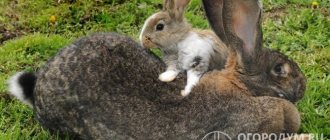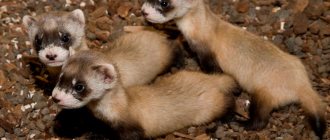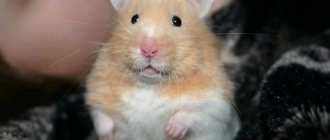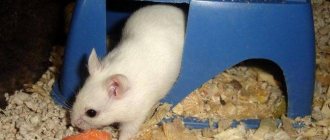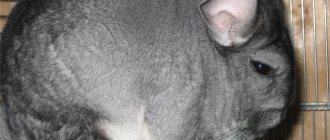03/24/2021 11,445 Chinchillas
Author: Olga
So that the chinchilla could survive in its natural habitat, nature gave it fur of modest colors. The most recognizable color of a chinchilla's coat is white on the tummy, gray on the back and sides. This is the basic color, the so-called standard. Shades from light ash to graphite are the framework within which this gray classic is designed. The breeders decided to change the scenario of nature and the chinchillas themselves, as they were a century ago.
[Hide]
One is gray, the other is white - colors
Experiments on crossing individuals have been ongoing for several decades in order to obtain skins of extraordinary beauty. The result of this work was such new shades as violet, diamond, sapphire, ebony...
Let's figure out exactly what shades these and other, no less spectacular, names encode. Let's find out who the degu and the Siberian chinchilla are. Does Siberian coloring even exist? What does the color of a degu look like? But before we answer these questions, let's talk about the basic gray color.
Strictly speaking, what we call “gray”, meaning the color of a wild rodent, is actually a more complex, three-color color. Just imagine a hair pigmented from tip to root with black, white and gray. It is very difficult to notice the zonality of coloring, because these hairs are located extremely close to each other.
The three-level coloring of the hairs, invisible to the eye, creates an amazing optical effect. – Depending on the depth of black, the purity of white and the shade of gray, the result is fur colored gray with varying degrees of intensity.
The highlight of the color is the silver tint or the so-called veil. These are the short-tailed chinchilla and the long-tailed chinchilla. – This is the name of two species of rodents of the chinchilla family. And the colors that these chinchilla breeds have in nature are standard.
The standard color has four types. Each type corresponds to the degree of color saturation: moderately dark standard, dark standard, extra-dark standard and medium standard. The most valuable is considered to be an individual of the extra-dark standard color.
The restrained beauty of the wild chinchilla is challenged by its domesticated relatives. They are expanding the number of species of rodents in the chinchilla family. And belonging to one or another depends not on the length of the tail, but on the color.
Popular colors of chinchillas
So, today many individuals of various stripes have been bred, the most popular of which are:
- White Wilson. Wilsons have several types: from milky to dark silver. All Wilsons have black eyes and a white tail tip. Two white Wilsons are not planted because two Wilsons have little chance of producing viable young.
- Pastel. Varieties of colors: light pastel, dark pastel, extra-dark pastel, medium pastel. Pastel colored animals darken with age.
- Black velvet. These animals have a white belly, black back and sides. The muzzle of the animal Black Velvet is also black. The more clearly the color contrast is manifested, the higher the individual is valued. Wilsons are often chosen as a pair for Black Velvet. And like the Wilsons, two Black Velvets are not planted together.
- Ebony. The ebony gene affects the degree of coloration of the tummy. If the animal's belly fur matches the color of its main fur, then it is real ebony.
- Homobeige. Homobeige fur is distinguished by uniform coloring. Homobeige animals have pink ears.
- Heterobeige. Unlike homobeige, heterobeige coats are colored unevenly: the tips of the hairs, like the undercoat, are darker than the main tone.
- Degu. Degu is a dwarf chinchilla. In nature, degus “wear” brown fur coats with a yellowish or grayish tint. It doesn't sound as impressive as, say, sapphire and diamond. And it doesn’t look as radical as, for example, an albino. However, breeders liked the small degu chinchillas. They try to recreate the degu color by crossing individuals of different colors.
Possible variations that result from crossing
When crossing animals of different colors, different colors are obtained. The number of possible options is so large that it is simply impossible to list them. Among them are White Velvet, Heteroebony, Homoebony and others.
Rare and spectacular chinchilla colors
Rare colors of rodents of the chinchilla family are:
- Sapphire. A blue chinchilla with a pearly white belly and pink ears: meet Sapphire. Individuals of the Sapphire color have low viability, so they are rare in their pure form.
- Royal Persian Angora. This is a long-tailed chinchilla, whose colors can be any. The most valuable types of Royal Persian Angoras are diamond and sapphire. The “royal” feature of Angoras is their long, beautiful hair. Thanks to their rich wool, Royal Angoras, even of standard color, look luxurious.
- White and pink coats belong to animals with beige and white genes. These genes make themselves felt in different ways, which is why there are several subspecies of pink and white colors. So, the white-pink color is both white, with beige marks, and beige, with white spots. But no matter what subspecies the white-pink color is classified as, the color of its owner’s ears will always be pink. To produce pink and white cubs, both the female and the male must be carriers of four genes at once. This is why white and pink colors are not common. Breeders really like individuals of this color, because the white and pink shade has a royal look!
- Violet. Animals of this color do not always have purple fur. The fur coat can be gray or purple. But a shade of violet is always present in the pigmentation of the nose. In order not to lose the violet gene, violet-colored individuals are planted exclusively with each other. However, sometimes breeders deviate from this rule, breeding individuals in shades of violet and black velvet.
So who is the Siberian chinchilla? Having listed a large number of colors, we still haven’t met the Siberian. It turns out that the Siberian chinchilla is a breed of cat. Attempts to find a “Siberian” shade (or anything else “Siberian”) in rodents of the chinchilla family are in vain.
But Siberian cats “borrowed” their zone-colored hairs from rodents. The surprisingly soft fur of Siberian cats added similarity to animals from different orders.
Black velvet
This species was bred in the last century. A feature at the genetic level is the presence of a lethal gene in the gene set. This suggests that such animals cannot be crossed with each other, otherwise they die in 100% of cases. It is for this reason that they are crossed only with their counterparts, with the exception of velvets. This crossing allows you to improve the saturation of shades and develop new colors. You can see the beauty of the color of these pets in the photo.
Black ebony chinchilla - what is it like? First, it's worth understanding what Ebony means. This is the degree of darkening of the belly to match the color of the animal. Chinchillas without ebony have a white belly.
Interesting. Chinchillas of this breed do not shed.
Black Velvet
This breed has some differences from its brothers, let’s look at them:
Genetic color calculator for chinchillas
The colors of chinchillas are very diverse. How to breed an individual of the desired color? Understanding the complex interweaving of pet genes can be quite difficult. A tool such as a genetic calculator comes to the aid of a chinchilla breeder. Using a genetic calculator, you can determine which color offspring is most likely to be born.
So, using this calculator, you can calculate that a Homoebony mother and a Homoebony dad will have almost 64% probability of producing Gomoebony cubs. There is a 22% chance that their babies will have the Extra-Dark Ebony color. The possibility of these parents having Ebony-dark babies is 10%. And in only 4% of cases, such a couple gives birth to Ebony-light and Ebony-medium cubs.
Animals with beige fur
The main shade of these rodents is pastel. However, it has several variations. In addition, the older the chinchilla, the darker its fur will be. It can be brown, red or beige. This type of rodent can be transverse.
Homobeige
This type of rodent has uniformly colored light beige fur and pink ears. Single dark hair is allowed in this shade.
Heterobeige
These rodents, on the other hand, have irregular colors. The entire coat is beige, the undercoat and tips of the hair are brown. When choosing a chinchilla, pay attention to the color difference between the rest of the body and the belly.
Beige tower
The fur color of these animals ranges from light to dark beige, which is paired with a brown pattern along the spine.
Brown velvet
The main color of the fur of these animals is beige, with a chocolate-colored back and head, and a sand-colored belly.
Wellman beige
The chinchilla has light beige fur, light ears and dark eyes.
Beige Sullivan
These rodents have rich beige fur and red eyes.
Video “Chinchilla colors”
This video features White and Pink Chinchilla, Angora Chinchilla, Beige Chinchilla, White Wilson. Here you can also see individuals of such colors as Brown Velvet, Homoebony, Homobeige, White Velvet, White Sapphire. The authors of the video also did not forget about the colors Albino, White Violet, Blue Diamond, Pastel, Ebony, Violet, Homobeige Sapphire, Sapphire, Black Velvet.
Was this article helpful?
Thank you for your opinion!
The article was useful. Please share the information with your friends.
Yes (75.00%)
No (25.00%)
X
Please write what is wrong and leave recommendations on the article
Cancel reply
Rate the benefit of the article: Rate the author ( 5 votes, average: 4.80 out of 5)
Discuss the article:
Care and maintenance at home
Keeping a chinchilla is as simple as keeping a decorative rat . There are many similarities in caring for these rodents. But it also has its own exceptional features.
What to feed
Chinchilla is not averse to snacking on a nut or bean
These furry animals are classified as herbivores, which determines their diet. It must contain food of plant origin. The best food for chinchillas:
- cereals;
- legumes;
- cacti;
- bark of bushes and trees;
- moss;
- fruits.
Useful vegetables include tomatoes, cucumbers, pumpkin, and carrots. You can give fresh herbs. In industrial breeding, hay is often the basis of the diet. At home, the pet is given a bunch of hay and 1 tablespoon of grain mixture every day. Add vegetables, fruits, herbs. Optimal grain mixture composition:
- oats (5 parts);
- wheat (2);
- sunflower seeds (1);
- flax seed (1);
- Hercules (2);
- peas (2);
- buckwheat (1);
- millet (1).
Hygiene and bathing
Bathing an animal in the sand will replace its bath
Chinchillas are clean animals that keep their fur clean. But they still need bathing. Water is not used for this, as there is a high risk of the animal catching a cold. Chinchillas need sand baths .
Place a container in the cage of such a size that the pet can fit completely in it, with free space remaining. Fill halfway with clean sand. If it is not possible to place such a bath in the enclosure, it is installed nearby and hygiene procedures are carried out during walking. Instead of sand, you can use special bulk materials that are sold in pet stores.
Diseases and treatment
Like any other pet, chinchillas suffer from a wide range of diseases and ailments. When kept at home, the most common are:
- constipation;
- diarrhea;
- conjunctivitis;
- keratitis;
- catarrh of the nose;
- otitis;
- runny nose;
- respiratory diseases: bronchopneumonia, pulmonary congestion.
Developmental defects are possible. Among the most common are incorrect bite or teeth color. If the conditions of detention are violated, the behavior of the animals may change and a problem such as gnawing out fur may arise. This causes injury to the skin and the formation of bald spots. The animal can gnaw out fur not only from itself, but also from its neighbors in the enclosure.
Alopecia may develop, accompanied by hair loss. The most common parasitic diseases are lichen and ectoparasites.
Chinchillas are not vaccinated.
Selecting a cage and accessories
A chinchilla should have a cozy and not boring corner
Chinchillas are kept in cages with metal bars that the animal cannot chew through . For one animal, a house measuring 70x70x50 cm is enough, for two - a more spacious room: 90x50x40 cm.
The optimal distance between the cage bars is 20 mm. In this case, the pet will not be able to stick its head into the gap and get injured.
The chinchillas' home is equipped in accordance with the requirements for houses for rodents. The cage must contain:
- drinking bowl;
- feeder;
- mineral stone for grinding teeth;
- nest for sleeping.
The cage is installed in a place protected from drafts and sunlight, away from heating devices. The contents of the drinking bowl are updated daily. The feeder should always be full. Sawdust or special granules that absorb moisture are used as bedding. The cage is cleaned once every 2–3 days.
To prevent the pet from getting bored, the house is equipped with play accessories. One of the mandatory ones is shelves suspended at different levels. The chinchilla will begin to jump on them, realizing its natural need for movement. An excellent choice would be a sleeping house with several entrances. The animal will play in it, like in a labyrinth. If space allows, a wheel and various tunnels are placed.
